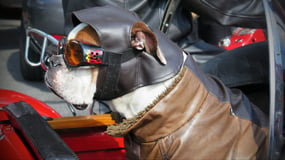Your Most Common Airline Pet Policy Questions Answered
Published on: April 14, 2022 | Author: Starwood Pet Travel
 Airlines around the world transport hundreds of thousands of animals every year. But the animals that matter to you are your own pets. They’re precious members of your family, and if you – and they – will be taking an airplane trip, you want to be sure you’re doing everything right so they can be comfortable and safe.
Airlines around the world transport hundreds of thousands of animals every year. But the animals that matter to you are your own pets. They’re precious members of your family, and if you – and they – will be taking an airplane trip, you want to be sure you’re doing everything right so they can be comfortable and safe.
Just as with human travel, airlines have policies and special procedures that relate to pet transport. Some pet policies apply universally to all airlines, but others are airline-specific. The following information will give you a good overview of what to expect if you’re preparing your cat or dog for air travel, but nothing should replace learning about your airline’s pet policies. If your pet’s itinerary includes multiple airlines or a layover somewhere, things may be even more complicated.
Where on the plane will my pet travel?
Cats and small dogs are sometimes allowed to travel in the cabin, under the seat in front of you. Some airlines allow you to check properly-kenneled pets as accompanied or excess baggage. All airlines that accept pets allow them to fly as cargo as well (depending on the aircraft). No matter where your pet travels, the space on the plane will be temperature-controlled, pressurized and oxygenated.
Many factors, including your pet's size, impact where your pet will be allowed to travel on the plane. Some of these factors are included below.
- Their breed - Brachycephalic cats and dogs have inherent respiratory challenges, so some airlines restrict their travel options and some embargo them altogether or embargo certain specific breeds (like Pugs or Bulldogs).
- The size of the plane - US federal regulations require that your pet’s kennel fit upright through the cargo hold doorway, and many smaller planes that serve smaller cities domestically and internationally cannot accommodate larger kennels. Additionally, some of the smaller planes do not have a cargo area that is temperature controlled, pressurized and oxygenated accordingly, so it would be unsafe for live animals to travel that way.
- Your destination country - Some countries, such as Australia, Hong Kong and the UAE will only allow pets to arrive as manifest cargo.
What else can vary?
- How far in advance you have to check in your pet, and where.
- How you go about making your pet's reservation and the cost.
- How many pets can travel with you on the same flight(s).
Airlines that accept pets set a limit on the total number of animals allowed on any given flight, so it’s important to make your pet’s reservations as early as possible, no matter where on the plane they will be traveling.
When can my pet fly?
If your cat or dog is allowed to accompany you inside the cabin, you may not find any scheduling restrictions. However, pets traveling in the hold are subject to weather-related policies used by every airline. Essentially, if the temperature is forecasted to be above 85oF or below 45oF at any point along your pet’s itinerary, your pet may not be allowed to fly. The concern is extreme heat or cold while pets are being moved to and from the plane or sitting on the tarmac, either in the plane on a stop or waiting to be loaded on.
This can mean no flying at all during the summer (May to September) to or from very hot locations. If it’s very cold but not below 20oF and your dog is acclimated to cold weather, American Airlines may make an exception based on an acclimation letter from your vet.
Can I use my pet’s regular carrier?
Probably not. All airlines require pets to travel in kennels that meet the specifications set forth by IATA (the International Air Transport Association) and the US Department of Agriculture (USDA), unless your pet is traveling in-cabin with you. Heavy-duty kennels for transport in baggage or cargo holds are designed for maximum safety and security to protect your pet. In-cabin, you can use a hard-sided carrier or soft-sided “Sherpa” bag, but it must fit underneath the seat in front of you. That sounds easy enough, but those dimensions differ from airline to airline.
Should I sedate my pet?
Veterinarians and airlines strongly advise against sedation, and top pet shipping companies simply forbid it, because tranquilizing animals can cause respiratory and cardiovascular issues when up in the air at high altitudes. It also eliminates their ability to maintain balance and confuses them, which can make them more anxious instead of calmer.
Check your destination country's import requirements.
It’s important to remember that every country has their own requirements for importing and exporting pets, primarily for the purpose of ensuring only verifiably healthy dogs and cats are granted entry. Despite any airline specific requirements, the import and exporting countries' requirements override some of these. Just because your airline allows something as a general rule, don’t assume this is the case for your destination country.
Your first act in preparing your pet for air travel should be to learn what documentation is required and what other policies apply to your destination country. The easiest and most reliable way to do this is by contacting an international pet transport service. It’s their job to get every detail right, and it’s their mission to make sure your pet has the best travel experience possible.
Starwood Animal Transport has rebranded to Starwood Pet Travel. We are still the same great company with the best team, just now with a slightly different name.
Subscribe to the Blog
Enjoy our content? Get them sent to your inbox!
Subscribe Now!


